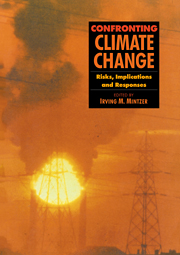Book contents
- Frontmatter
- Contents
- Foreword
- Acknowledgements
- List of Reviewers
- 1 Living in a Warming World
- I The Science of Climate Change
- II Impacts of Global Climate Change
- III Energy Use and Technology
- 12 The Energy Predicament in Perspective
- 13 Electricity: Technological Opportunities and Management Challenges to Achieving a Low-Emissions Future
- 14 Transportation in Developing Nations: Managing the Institutional and Technological Transition to a Low-Emissions Future
- IV Economics and the Role of Institutions
- V Equity Considerations and Future Negotiations
- Annex I
- Annex II
- Glossary
- Index
12 - The Energy Predicament in Perspective
Published online by Cambridge University Press: 06 January 2010
- Frontmatter
- Contents
- Foreword
- Acknowledgements
- List of Reviewers
- 1 Living in a Warming World
- I The Science of Climate Change
- II Impacts of Global Climate Change
- III Energy Use and Technology
- 12 The Energy Predicament in Perspective
- 13 Electricity: Technological Opportunities and Management Challenges to Achieving a Low-Emissions Future
- 14 Transportation in Developing Nations: Managing the Institutional and Technological Transition to a Low-Emissions Future
- IV Economics and the Role of Institutions
- V Equity Considerations and Future Negotiations
- Annex I
- Annex II
- Glossary
- Index
Summary
Editor's Introduction
Paradoxically, the use of energy contributes considerably to human well-being—and to the environmental risks that threaten the quality of human life. Energy is the essential engine of economic development, but the extraction, mobilization, and supply of energy generate risks to human health and may also endanger natural ecosystems. The consumption of energy releases dangerous pollutants to air, water, and soil.
In this chapter, John Holdren shows us that the world is not running out of energy — not in any absolute sense. Instead, the most important and problematic costs of energy supply are the environmental and sociopolitical ones. Holdren's list of what we are running out of—from political will to patience to atmospheric room for the pollutants from fossil fuels—is one of the most compelling arguments made about energy policies today. He particularly focuses on the imbalances and inequities in the current pattern of global energy use: fully three-quarters of global primary energy is supplied by fossil fuels, and two-thirds of the total supply is consumed by the 20% of today's population which lives in the industrialized world. As with food supply and disaster relief, the poor bear the brunt of the energy problem. They often have too little energy to meet basic human needs and pay too high a cost for what they can get.
Among the environmental problems caused by energy, Holdren suggests that the most troublesome are not local impacts—which can certainly be painful and disruptive— but the transboundary effects that stretch across continents and, indeed, span the globe. These include radioactive plumes, acidic precipitation, and the atmospheric buildup of greenhouse gases.
- Type
- Chapter
- Information
- Confronting Climate ChangeRisks, Implications and Responses, pp. 163 - 170Publisher: Cambridge University PressPrint publication year: 1992
- 1
- Cited by

